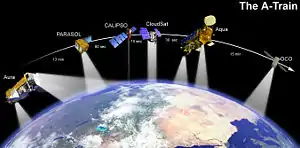Parasol (satellite)
PARASOL (Polarization & Anisotropy of Reflectances for Atmospheric Sciences coupled with Observations from a Lidar) was a French-built Earth observing research satellite. It carried an instrument called POLDER which studied the radiative and microphysical properties of clouds and aerosols.
| Mission type | Earth Observation |
|---|---|
| COSPAR ID | 2004-049G |
| SATCAT no. | 28498 |
| Website | https://parasol.cnes.fr/en/PARASOL/index.htm |
| Mission duration | 9 years |
| Start of mission | |
| Launch date | December 18, 2004 |
| Rocket | Ariane 5 |
| Launch site | Kourou, French Guiana |
| Contractor | b |
| End of mission | |
| Deactivated | December 18, 2013 |
| Orbital parameters | |
| Reference system | Geocentric |
| Regime | Sun-synchronous |

PARASOL was launched from the French spaceport in Kourou, French Guiana on December 18, 2004, by an Ariane 5 G+.
It flew in formation in the "A Train" constellation with several other satellites (Aqua, CALIPSO, CloudSat and Aura). These satellites had, for the first time ever, combined a full suite of instruments for observing clouds and aerosols, from passive radiometers to active lidar and radar sounders.
On 2 December 2009, PARASOL was manoeuvred out of the A-Train, dropping some 4 km below the other satellites by early January 2010.[1]
The satellite's mission was formally ended exactly 9 years after launch on December 18, 2013.[2]
External links
References
- The PARASOL Satellite Moving Off the A-Train's Track, Angelita Kelly & Rob Gutro, Goddard Space Flight Center, 4 January 2009, accessed 6 January 2009
- PARASOL eoPortal Directory accessed 14 June 2016